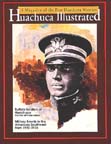 Huachuca
Illustrated, vol 1, 1993:
Huachuca
Illustrated, vol 1, 1993: Huachuca
Illustrated, vol 1, 1993:
Huachuca
Illustrated, vol 1, 1993:
chuca Illustrat
chuca Illustrat
Buffalo Soldiers at Huachuca:
Organizing the Punitive Expedition
chuca Illustrat
American reaction to the, 9 March raid on Columbus, New Mexico, by Pancho Villa was immediate. A flurry of diplomatic notes made clear to Carranza that the United States expected the de facto government in Mexico to take steps to hunt down and bring to justice Villa and his Army so that the threat to the American border would be eliminated. But few in Washington or in the Southwest believed that the beleaguered Carranza government had the power to do so.
The day after the raid Major General Funston was wiring Washington recommending a pursuit be organized. Funston was of the opinion that "unless Villa is relentlessly pursued and his forces scattered he will continue raids. As troops of the Mexican Government are accomplishing nothing and, as he consequently can make his preparations and concentrations without being disturbed, he can strike at any point on the border ...."

"U.S. Artillery in Action." Photo by W. H. Horne, El Paso, Texas.
Secretary of War Newton D. Baker, new on the job, called Chief of Staff of the Army, Maj. Gen. Hugh L. Scott, into a huddle and told him, "I want to start an expedition into Mexico to catch Villa."
 Major General Hugh Lenox Scott.
Major General Hugh Lenox Scott.
According to Scott, "This seemed strange ... and I asked: 'Mr. Secretary, do you want the United States to make war on one man? Suppose he should get onto a train and go to Guatemala, Yucatan, or South America; are you going to go after him?'"
"He said, 'Well, no, I am not.'"
"'That is not what you want then. You want his band captured or destroyed,' I suggested."
"'Yes,' he said, 'that is what I really want.'"
"And after his approval the ... telegram was sent to General Funston ... in which it will be seen that no mention is made of the capture of Villa himself."(46)
Funston received that telegram on 10 March. It gave him the go-ahead to organize the punitive expedition and named Brig. Gen. John J. Pershing as the commander.
Although the State Department was assuring the Carranza government that the expedition was being undertaken in a spirit of cooperation with the Mexican government to rid it of Villa's lawless element, Carranza was having none of it and he vigorously protested what he considered to be an intrusion upon Mexican sovereignty. The official resistance of the Mexican government would be another problem with which Pershing would have to contend and at a place called Carrizal it would prove to be a deadly one.
Mexican railroads. Reproduced in Army Service Schools Manual, May 1914.
General Alvaro Obregon and General Frederick Funston
in El Paso, Texas, 1916.
Photo courtesy Col. James W. Fraser.
In Pershing's Report of the Punitive Expedition to June 30, 1916, he quotes a telegram from General Obregon, Secretary of War and Navy, to his commanders outlining an American-Mexican agreement for hot pursuit of bandits across the border. It was this telegram that the U.S. troops carried and showed to local commanders as the basis for their authorization to be in Mexico. It was dated the 13th of March and read:
Our government having entered into an agreement with that of the United States of the North, providing that the troops of either government may cross the border, in pursuit of bandits who are committing depredations along our frontier, I advise you of same in order that you may in turn advise all commanders along the borders in order that they may make judicious use of these powers, taking care in each case to act in accord with the military authorities of the American army in order that the pursuit of these bandits may give the best results.
General Orders No. 1, published on 14 March 1916, organized the Punitive Expedition and enjoined "all members of the command to make the utmost endeavor to convince all Mexicans that the only purpose of this expedition is to assist in apprehending and capturing Villa and his bandits. Citizens as well as soldiers of the de facto Government will be treated with every consideration. They will not in any case be molested in the peaceful conduct of their affairs, and their property rights will be scrupulously respected.(47)

"Militiamen Breaking Outlaws." Photo by W. H. Horne Co., El Paso,
Texas.
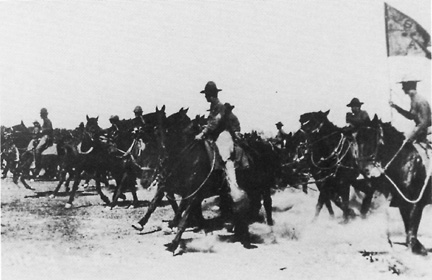
"U.S. Artillery going into Action." Photo by W. H. Horne, El Paso,
Texas.

"Truck Co. #73 in Mexico." Photo by W. H. Horne, El Paso, Texas.
National Guard troops at Huachuca in 1916, replacing the 10th Cavalry which was in the field in Mexico. The 2d California Infantry from northern California was sent to Fort Huachuca with Lt. Col Scherer as regimental commander. The 2d went into camp on the target range north of the Main Post area while the 7th California Infantry (48) arrived from Camp Stephen D. Little to pitch camp in Garden Canyon. The regiments would exchange places during the year. The 2d Idaho Infantry arrived from Camp Stephen D. Little in August 1916 for rifle range practice and summer maneuvers.
The President called up the militias of Arizona, New Mexico and Texas on May 9th, 1916. The Arizona militia was mustered in by May 19, Texas was ready by June 20, and the militia forces of New Mexico were completing their mustering in by August. Three weeks after the passage of the 1916 National Defense Act in late June, the National Guard of all of the states (except Nevada which did not have a militia), and Alaska and the District of Columbia were called into Federal service. There were as many as 111,954 guardsmen along the border at the end of August 1916.(49)

A camp of the 1st California Infantry at Fort Huachuca in 1916. This photo
was available as a post card.
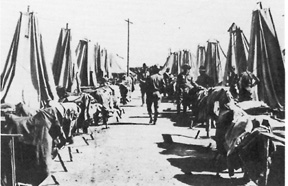
Mushroomed tents, Camp Harry J. Jones, Douglas, Arizona.
Douglas, Arizona, was one of the four assembly points for the guard units. The others were San Antonio, Brownsville, and El Paso, Texas. Stationed all along the Texas and Arizona borders with Mexico, none of the guard units ever crossed into the neighboring nation.(50)

The 1st Arizona Infantry at Naco, guard post in 1916. The Arizona National
Guard was called into active federal service on 9 May 1916, with Col. Alexander
McKenzie Tuthill as regimental commander. Besides being stationed at Naco,
there were elements at Ajo, Nogales, Fort Huachuca, Douglas and other border
outposts.(51)

"First Ariz Infantry Field Hospital." Photo by W. H. Horne, El
Paso, Texas.

American field headquarters, near Namiquipa, Mexico, 10 April 1916. The
6th Infantry resting after its long hike. U.S. Army Signal Corps photo 195554.
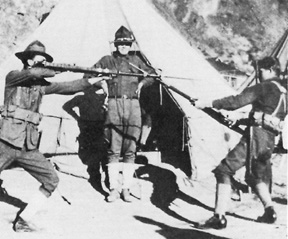 --
--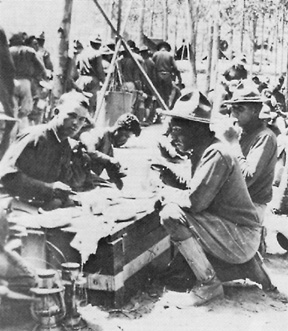
A posed bayonet drill by members of a National Guard unit
--------------First Arizona Infantry (158th
Infantry)
stationed along the Mexican border during the----------------------------at Camp Kearny, California, in 1917.
1916 Punitive Expedition.------------------------------------------------Photo courtesy Paul Ballinger.
Footnotes:
46. Scott, Hugh B., Some Memories of a Soldier, New York, 1928.
48. Later the 7th became the 160th Infantry, 40th Division, and it would be sent to France in World War I.
50. One of the new second lieutenants sent to the border was Omar Nelson Bradley, 14th Infantry. From September 1915 to May 1916, he was at Douglas where he lived "in absolutely miserable circumstances." He kept busy operating the target range, coaching the regimental baseball team and "participated in an epic experimental 300-mile 'motorized hike' with a convoy of trucks." He was moved to Nogales from July to September 1916, and then to Yuma from September 1916 to 21 May 1917. He said: "Duty at Yuma was miserable. Clearly there was to be no war with Mexico; the official camp duties were routine and boring, Yuma was primitive and dusty. Our major diversion was the tedious round of formal calls on superiors for tea or coffee. A few weeks after Mary and I settled in, I applied for a transfer.... Any place seemed preferable to Yuma, Arizona' " [Bradley, Omar N., and Blair, Clay, A General's Life, Simon and Schuster, NY, 1983.] Other young officers who were to gain prominence and who were stationed along the border were: Clarence Huebner (2d Lieut. at Douglas, AZ, in 1912), Matthew B. Ridgway (2d Lieut. At Eagle Pass, Texas, in 1917), Carl A. Spaatz (aviator with 1916 Pershing Expedition), Lucian K. Truscott (2d Lieut. with 17th Cavalry at Douglas in 1917), Jonathan M. Wainwright (Capt., 1st Cavalry, in 1916), Walton H. Walker (2d Lieut. in Texas in 1914), Terry Allen (1st Lieut., 1912-17), Malin Craig (aide-de-camp to General Bell in 1915), William J. "Wild Bill" Donovan (with NY National Guard during 1916 Pershing Expedition), Hugh A. Drum (aide-de camp to General Funston in 1914), George S. Patton, (8th Cavalry and aide-de-camp to General Pershing in 1916), Robert L. Eichelberger (Lieut. in 1911 with 10th Infantry, and in 1915 with 22d Infantry), Leslie J. McNair (with 1916 Pershing Expedition), George C. Marshall ( a 1st Lieut.. in Texas Maneuver Division in 1911), Alexander McCarroll Patch (1st Lieut. in 18th Infantry in 1910), and George E. Straterneyer (2d Lieut. 7th Infantry at Douglas in 1914).
51. On 5 August 1917 the 1st Arizona Infantry was continued in federal service by order of the President and was redesignated the 158th Infantry. It was sent to camp Kearny, California, where it was brigaded with the 157th Infantry from Colorado in the 40th Infantry Division. The regiment served in France in World War I and was demobilized 3 May.